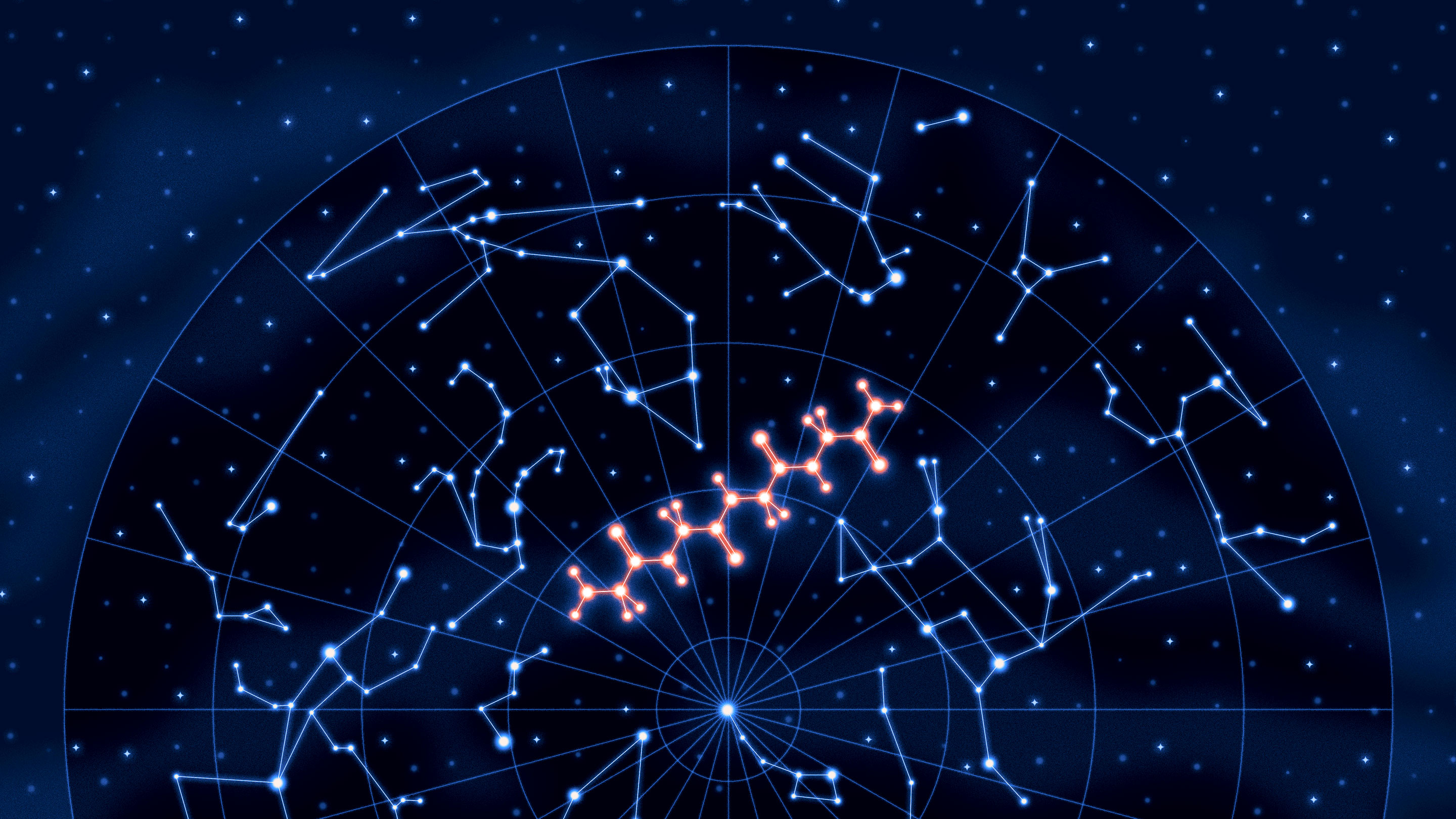Peptides on Stardust May Have Provided a Shortcut to Life

The spontaneous formation of peptide molecules on cosmic dust in interstellar clouds could have implications for theories about the origin of life.
Kristina Armitage / Quanta Magazine
Introduction
Billions of years ago, some unknown location on the sterile, primordial Earth became a cauldron of complex organic molecules from which the first cells emerged. Origin-of-life researchers have proposed countless imaginative ideas about how that occurred and where the necessary raw ingredients came from. Some of the most difficult to account for are proteins, the critical backbones of cellular chemistry, because in nature today they are made exclusively by living cells. How did the first protein form without life to make it?
Scientists have mostly looked for clues on Earth. Yet a new discovery suggests that the answer could be found beyond the sky, inside dark interstellar clouds.
Last month in Nature Astronomy, a group of astrobiologists showed that peptides, the molecular subunits of proteins, can spontaneously form on the solid, frozen particles of cosmic dust drifting through the universe. Those peptides could in theory have traveled inside comets and meteorites to the young Earth — and to other worlds — to become some of the starting materials for life.
The simplicity and favorable thermodynamics of this new space-based mechanism for forming peptides make it a more promising alternative to the known purely chemical processes that could have occurred on a lifeless Earth, according to Serge Krasnokutski, the lead author on the new paper and a researcher at the Max Planck Institute for Astronomy and the Friedrich Schiller University in Germany. And that simplicity “suggests that proteins were among the first molecules involved in the evolutionary process leading to life,” he said.
Whether those peptides could have survived their arduous trek from space and contributed meaningfully to the origin of life is very much an open question. Paul Falkowski, a professor at the School of Environmental and Biological Sciences at Rutgers University, said that the chemistry demonstrated in the new paper is “very cool” but “doesn’t yet bridge the phenomenal gap between proto-prebiotic chemistry and the first evidence of life.” He added, “There’s a spark that’s still missing.”
Still, the finding by Krasnokutski and his colleagues shows that peptides might be a much more readily available resource throughout the universe than scientists believed, a possibility that could also have consequences for the prospects for life elsewhere.
Cosmic Dust in a Vacuum
Cells make the production of proteins look easy. They manufacture both peptides and proteins extravagantly, empowered by environments rich in useful molecules like amino acids and their own stockpiles of genetic instructions and catalytic enzymes (which are themselves typically proteins).
But before cells existed, there wasn’t an easy way to do it on Earth, Krasnokutski said. Without any of the enzymes that biochemistry provides, the production of peptides is an inefficient two-step process that involves first making amino acids and then removing water as the amino acids link up into chains in a process called polymerization. Both steps have a high energy barrier, so they occur only if large amounts of energy are available to help kick-start the reaction.
Because of these requirements, most theories about the origin of proteins have either centered on scenarios in extreme environments, such as near hydrothermal vents on the ocean floor, or assumed the presence of molecules like RNA with catalytic properties that could lower the energy barrier enough to push the reactions forward. (The most popular origin-of-life theory proposes that RNA preceded all other molecules, including proteins.) And even under those circumstances, Krasnokutski says that “special conditions” would be needed to concentrate the amino acids enough for polymerization. Though there have been many proposals, it isn’t clear how and where those conditions could have arisen on the primordial Earth.
But now researchers say they’ve found a shortcut to proteins — a simpler chemical pathway that reenergizes the theory that proteins were present very early in the genesis of life.
Last year in Low Temperature Physics, Krasnokutski predicted through a series of calculations that a more direct way to make peptides could exist under the conditions available in space, inside the extremely dense and frigid clouds of dust and gas that linger between the stars. These molecular clouds, the nurseries of new stars and solar systems, are packed with cosmic dust and chemicals, some of the most abundant of which are carbon monoxide, atomic carbon and ammonia.
In their new paper, Krasnokutski and his colleagues showed that these reactions in the gas clouds would likely lead to the condensation of carbon onto cosmic dust particles and the formation of small molecules called aminoketenes. These aminoketenes would spontaneously link up to form a very simple peptide called polyglycine. By skipping the formation of amino acids, reactions could proceed spontaneously, without needing energy from the environment.
To test their claim, the researchers experimentally simulated the conditions found in molecular clouds. Inside an ultrahigh vacuum chamber, they mimicked the icy surface of cosmic dust particles by depositing carbon monoxide and ammonia onto substrate plates chilled to minus 263 degrees Celsius. They then deposited carbon atoms on top of this ice layer to simulate their condensation inside molecular clouds. Chemical analyses confirmed that the vacuum simulation had indeed produced various forms of polyglycines, up to chains 10 or 11 subunits long.
The researchers hypothesized that billions of years ago, as cosmic dust stuck together and formed asteroids and comets, simple peptides on the dust could have hitchhiked to Earth in meteorites and other impactors. They might have done the same on countless other worlds, too.
The Gap From Peptides to Life
The delivery of peptides to Earth and other planets “certainly would provide a head start” to forming life, said Daniel Glavin, an astrobiologist at NASA’s Goddard Space Flight Center. But “I think there’s a large jump to go from interstellar ice dust chemistry to life on Earth.”
First the peptides would have to endure the perils of their journey through the universe, from radiation to water exposure inside asteroids, both of which can fragment the molecules. Then they’d have to survive the impact of hitting a planet. And even if they made it through all that, they would still have to go through a lot of chemical evolution to get large enough to fold into proteins that are useful for biological chemistry, Glavin said.
Is there evidence that this has happened? Astrobiologists have discovered many small molecules including amino acids inside meteorites, and one study from 2002 discovered that two meteorites held extremely small, simple peptides made from two amino acids. But researchers have yet to discover other convincing evidence for the presence of such peptides and proteins in meteorites or samples returned from asteroids or comets, Glavin said. It’s unclear if the nearly total absence of even relatively small peptides in space rocks means that they don’t exist or if we just haven’t detected them yet.
But Krasnokutski’s work could encourage more scientists to really start looking for these more complex molecules in extraterrestrial materials, Glavin said. For example, next year NASA’s OSIRIS-REx spacecraft is expected to bring back samples from the asteroid Bennu, and Glavin and his team plan to look for some of these types of molecules.
The researchers are now planning to test whether bigger peptides or different types of peptides can form in molecular clouds. Other chemicals and energetic photons in the interstellar medium might be able to trigger the formation of larger and more complex molecules, Krasnokutski said. Through their unique laboratory window into molecular clouds, they hope to witness peptides getting longer and longer, and one day folding, like natural origami, into beautiful proteins that burst with potential.



